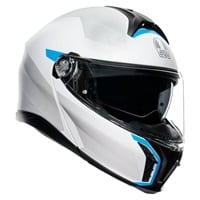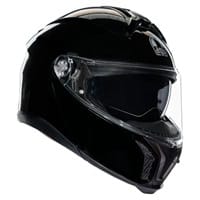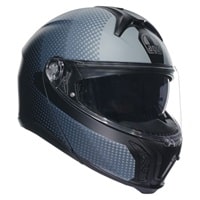The AGV Tourmodular is AGV’s latest and greatest flip-front helmet, and it’s a serious contender for the top spot in the modular helmet market. It combines premium safety features with versatile functionality for modern riders. The helmet’s carbon-aramid-fiberglass shell construction and ECE 22.06 certification showcase AGV’s commitment to rider protection.
But what sets the AGV Tourmodular apart from other modular motorcycle helmets? In this AGV Tourmodular Review, we will examine whether it delivers the perfect balance of comfort, safety, and versatility that today’s riders demand.
AGV Tourmodular
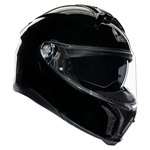
Key Takeaways
- Large 190×85 degree field vision
- Five-density EPS for superior protection
- Secure Modular mechanism
Our Final AGV Tourmodular Verdict
After testing the AGV Tourmodular for over 2,000 miles, I’m convinced it represents a significant step forward in flip up helmet design.
The ECE 22.06 certification and premium construction immediately caught my attention, but it’s the real-world performance that truly impressed me.
I really like how the ventilation handles varying conditions.
During my summer testing, it was comfortable even in 95°F heat, while the Pinlock insert prevented fogging in cold morning rides.
The 190-degree field of view proved invaluable during city commuting, offering exceptional peripheral vision for lane changes.
In my experience, the carbon-aramid-fiberglass shell strikes an excellent balance between protection and weight. The 4.3-pound (XL) feels well-distributed, causing minimal neck fatigue even after 8-hour trips.
I did notice several issues that you should consider before purchasing. The chin bar mechanism proves stubborn with gloves, often requiring bare hands to operate. The neck opening feels tight initially, which might concern riders with wider necks.
While the Insyde communication system is nicely integrated, it sometimes struggles with voice commands when the chin bar is closed.
Before making your purchase, check out Revzilla.com for current prices and special offers on the AGV Tourmodular. Their price match guarantee ensures you’ll get the best deal available.
If you found this review helpful, please like and share it – it helps other riders find this information and lets Google know you value the content.
Features:
- Carbon, aramid, fiberglass layered blend shell construction
- 3 shell sizes: XS-MD, LG, XL-2XL
- 4 EPS liners
- Chin guard opening system designed to prevent accidental opening
- Shell shape designed to maximize aerodynamic performance and to have 0 dynamic weight at 80 mph (130 km/h)
- 5-density EPS Carbon-aramid-fiberglass shell
- Collarbone safe profile
- Metal chin guard block system ensures the double homologation P/J Ventilation
- 4 front vents, adjustable air vents and 1 rear extractors
- 2-step chin guard mechanism designed to optimize aerodynamics in jet configuration
- Removable and washable interiors
- Ritmo fabric, fresh and fluid cheek pads
- Removable wind protector
- Removable nose guard
- Shalimar fabric crown pad for a soft and gentle touch
- Reflective inserts
- Fit especially designed to allow wearing glasses
- Sanitized, antibacterial protection
- Dryspeed instant sweat absorption
- Embracing neck roll profile
- Ritmo fabric and synthetic leather neck roll with high abrasion resistance and water-resistant properties
- Microsense premium skin comfort interior
- Cheek pads interchangeable between all sizes
- Micro-opening system
- Anti-scratch, optic class 1 face shield with a 85° vertical field of view and a 190° horizontal field of view
- Integrated anti-scratch sun visor, removable without using tools
- Metal visor mechanism
- Extra quick release system
- Multistep visor mechanism
- Visor lock system
- 100% Max Vision Pinlock (120) included
- Steel micrometric retention system
- DOT approved
- ECE 22.06 regulation and the dual P/J homologation
Comparison to Similar Models
| Weight in lbs | Safety Certifications | Bluetooth | Noise Levels | Glasses | |
|---|---|---|---|---|---|
| AGV Tourmodular | 3.57 – 4.3 | ECE 22.06 | AGV Insyde communication system | 99 dB | Glasses friendly |
| HJC i91 | 3.79 | DOT and ECE 22.05 | Smart HJC communication systems compatibility | Moderate | Glasses friendly |
| Sedici Sistema II Parlare | 3.7 | DOT and ECE 22.05 | Integrated Sena DWO-6 System | Average to good | Glasses friendly |
| Schuberth C5 | 3.74 | ECE 22.06, DOT | Schuberth SC2 system | 85 dB at 75 mph | Glasses friendly |
| Shoei Neotec 3 | 4.12 | ECE 22.06, DOT, P/J homologation | Sena SRL3 System | Exceptional | Glasses friendly |
| HJC i100 | 4.4 | DOT and ECE 22.06 | Smart HJC 10B and 20B Systems | 101 dB | Glasses grooves |
| Scorpion EXO-GT930 EXO | 4-5 | DOT and ECE | Scorpion EXO-COM system | Average | Glasses friendly |
Note: Some specifications, such as weight and noise levels, may vary depending on the size and configuration of the helmet.
Sizing: Finding Your Perfect Fit
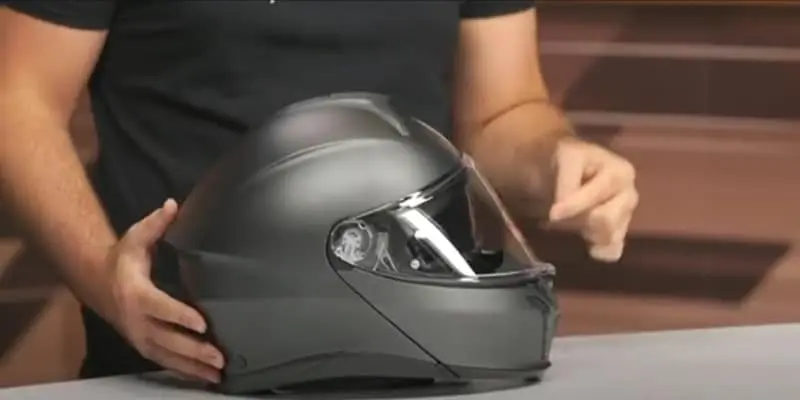
The sizing runs true to measurements, with options from XS (53-54cm) to XXL (63-64cm). It uses three outer lidd sizes and four inner sizes to maintain proper proportions across the size range.
Shell Construction and Comfort
The carbon-aramid-fiberglass shell provides a more accommodating fit than its predecessor, the Sportmodular. The interior offers ample room around the face and chin area, eliminating the claustrophobic feeling some riders experienced with earlier models.
Customization Options
Padding System
- Various thickness cheek pads ($83/pair) for a personalized fit
- Removable, washable interior liner
- Water-repellent collar and interior sections
Fit Considerations
It works well for intermediate oval head shapes, though riders should note:
- The neck opening may feel snug initially
- Glasses fit comfortably with dedicated channels
- It may require a break-in period for jaw pressure
- European sizing differs from Asian brands
The improved interior space and adjustable padding create a more versatile fit than previous AGV models. It demonstrates excellent stability at speed with minimal buffeting, suggesting a proper aerodynamic design for long-distance comfort.
The sizing chart applies to both men and women, as sizing is based on head measurements rather than gender:
| Size | Centimeters | Hat Size | Inches |
|---|---|---|---|
| XXS | 51-52 | 6 3/8 – 6 1/2 | 20.0 – 20.5 |
| XS | 53-54 | 6 5/8 – 6 3/4 | 20.9 – 21.3 |
| S | 55-56 | 6 7/8 – 7 | 21.7 – 22.1 |
| M | 57-58 | 7 1/8 – 7 1/4 | 22.4 – 22.8 |
| L | 59-60 | 7 3/8 – 7 1/2 | 23.2 – 23.6 |
| XL | 61-62 | 7 5/8 – 7 3/4 | 24.0 – 24.4 |
| 2XL | 63-64 | 7 7/8 – 8 | 24.8 – 25.2 |
| 3XL | 65-66 | 8 1/8 – 8 1/4 | 25.6 – 26.0 |
To measure your head size, Wrap a measuring tape around your head about 1 inch above your eyebrows, passing above your ears to the fullest part at the back of your head. The resulting measurement in centimeters corresponds to your helmet size.
Luxurious Interior: Materials and Comfort
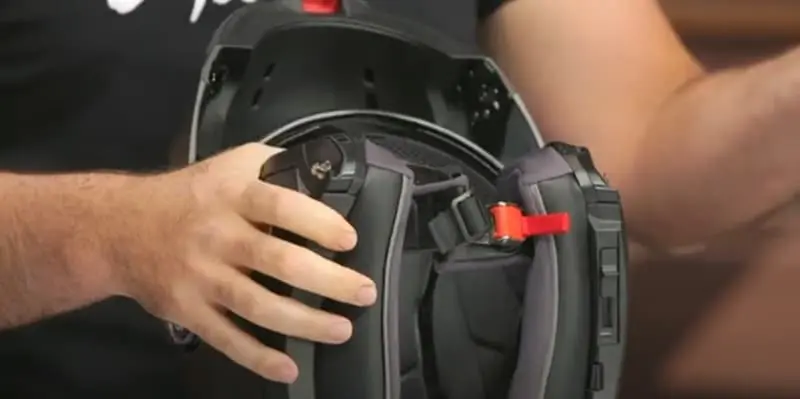
It combines Ritmo and Shalimar fabrics to create a plush, comfortable interior. The cooling Ritmo material covers the cheek pads while the soft Shalimar fabric lines the crown area.
Moisture Management
The interior’s moisture-wicking properties proved effective during extended summer trips. A plastic-bottomed neck roll prevents water absorption during rain, keeping the padding dry in wet conditions. The removable liner allows easy washing to maintain freshness.
Comfort Features
It fits true to size and requires minimal break-in time. I found the padding creates an ideal balance of pressure points, eliminating hot spots during longtrips. The interior includes recessed channels that comfortably accommodate prescription glasses.
Temperature Control
The fabric combination works effectively to:
- Maintain comfort in high humidity
- Prevent sweat buildup during summer trips
- Keep a consistent internal temperature
Long-Term Performance
The interior padding maintains shape and comfort even after multiple washes. Riders report excellent comfort levels during multi-day tours, with it performing well in various weather conditions. The micro-ratchet chin strap adds to the comfort of a secure yet comfortable closure.
The interior design focuses on all-day comfort, making it ideal for extended touring use. The premium materials and thoughtful construction create motorcycle helmets that are comfortable for morning commutes and cross-country adventures.
Tourmodular vs Sportmodular Comparison
| Feature | Tourmodular | Sportmodular |
|---|---|---|
| Shell Material | Carbon-aramid-fiberglass blend | All carbon fiber |
| Interior Liner | Standard comfort liner | Reversible hot/cold liner |
| Weight | 4.3 pounds (XL) | Lighter construction |
| Face Shield | 4mm thickness | Standard thickness |
The table above shows the available color options and their respective prices. It includes basic variants like Matt Black and Gloss Black, as well as more complex color schemes like White/Grey/Black/Red and Frequency graphic design.
A few additional notes about color options:
- The solid colors (matt and gloss black) are the most affordable options
- Graphic designs like “Frequency” command a premium price
- The paint quality, particularly on matt finishes, is reported to be very good
Weight Specifications
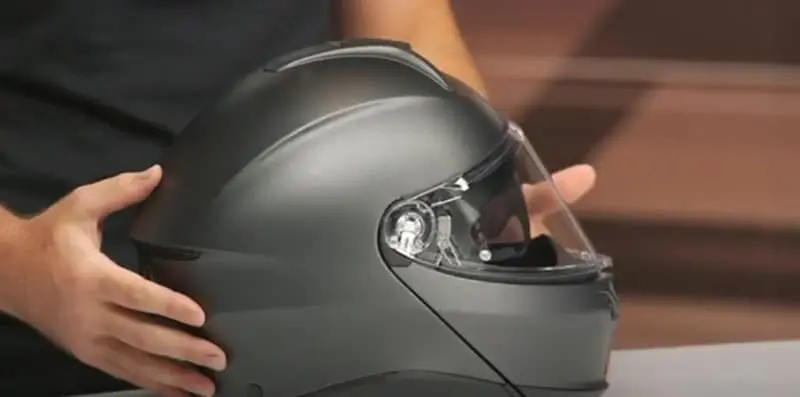
It weighs 1,620 grams (3.57 lbs) in its smallest size. I tested the XL size which came in at 1,950 grams (4.3 lbs).
Weight Distribution By Size
| Size | Grams | lbs |
|---|---|---|
| XS-M | 1,620 | 3.57 |
| L | 1,703 | 3.75 |
| XL-XXL | 1,950 | 4.30 |
Weight Performance
The lids design creates zero dynamic weight at 130 km/h (80 mph). During my highway testing, this translated to minimal neck fatigue, even on long trips.
Weight Comparison
| Model | Weight (lbs) |
|---|---|
| AGV Sportmodular | 2.85 |
| AGV Tourmodular | 3.57 |
| Schuberth C5 | 3.74 |
| Shoei Neotec II | 3.85 |
The carbon-aramid construction places the Tourmodular in the mid-range weight category for flip over motorcycle helmets. While heavier than the pure carbon Sportmodular, the weight remains well-distributed and comfortable during extended trips.
Safety First: Unpacking the ECE 22.06 Standard and Beyond

It meets the stringent ECE 22.06 standard, significantly advancing protection. The certification includes rigorous testing at multiple impact speeds, ranging from 6 m/s to 8.2 m/s, and introduces new oblique impact assessments.
Enhanced Protection Features
The 4mm-thick face shield doubles the standard thickness, providing superior impact resistance. The carbon-aramid shell incorporates five-density EPS layers, creating a collarbone-safe profile that reduces injury risk during accidents.
Dual Homologation Benefits
The P/J certification confirms the Tourmodular’s in both full-face and open configurations. The metal locking mechanism on the right pivot secures the chin bar in the up position, though I found it challenging to operate while wearing gloves.
Chin Bar Security
AGV’s track record shows exceptional chin bar reliability. Previous AGV flip back lids maintained chin bar integrity in 127 out of 128 impact tests. The locking mechanism features:
- Metal construction for durability
- Innovative release button design
- Precise engagement system
Testing Innovations
The ECE 22.06 standard introduces critical safety improvements:
- Brain injury criterion (BrIC) measurements
- Rotational acceleration limits of 10,400 rad/s²
- Multiple impact points testing
- UV exposure and environmental conditioning
he lids design achieves zero dynamic weight at 80 mph, reducing neck strain during long trips. This feature, combined with the dual homologation, creates versatile touring motorcycle helmets that maintains protection in various riding conditions.
Ventilation: Cool Under Pressure
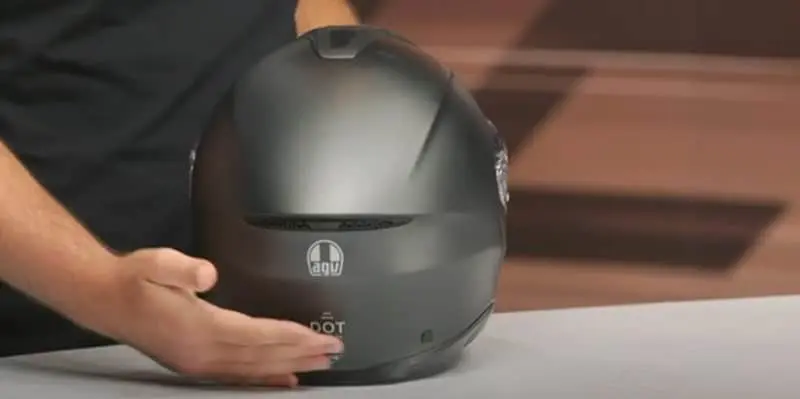
The Tourmodular’s ventilation design is considered by many bikers as superior to the top -of-the-line Sportmodular’s ventilation. This model features five intake vents and two exhaust ports. I first tested this modular motorcycle helmet in temperatures ranging from 45°F to 95°F across various riding conditions.
Front Airflow Design
The chin vent first directs air upward to the face shield, preventing direct airflow that causes lip chapping. Two forehead vents first channel cool air through the EPS liner’s internal channels. The vents operate with gloved hands through large, easy-to-find switches.
Performance Analysis
City Riding
It maintains good airflow at urban speeds (25-40 mph). The chin vent provides adequate fresh air even during stop-and-go traffic.
Highway Performance
At speeds above 65 mph, the cooling system moves significant air volume through. The rear extractors create effective negative pressure for continuous airflow.
Temperature Management
| Condition | Temperature | Effectiveness |
|---|---|---|
| Summer City | 85-95°F | Good airflow at stops |
| Highway | 65-75°F | Excellent circulation |
| Winter | 45-55°F | Manageable with closed vents |
Design Limitations
The non-removable chin curtain restricts some lower airflow. During humid conditions above 85°F, it can feel warm at city speeds. The top vents create minimal wind noise, though the chin vent produces some whistling above 70 mph.
Visor: A Clear View of Features and Performance
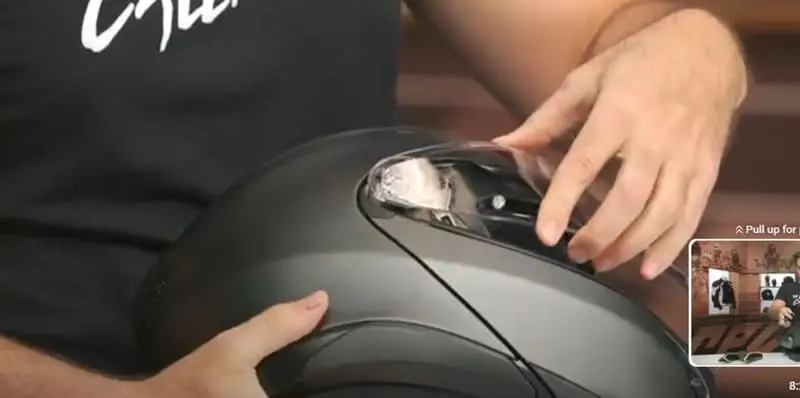
The visor provides a 190×85-degree field of view, surpassing standard visibility ranges. The 4mm-thick face shield doubles the typical visor thickness, meeting ECE 22.06 impact requirements.
Field of Vision Performance
The wide aperture allows me to spot vehicles in my peripheral vision without my head turning. During my testing, this extra visibility proved valuable for:
- Lane position awareness
- Blind spot checks
- Intersection scanning
Technical Features
Shield Construction
- 4mm optical-grade polycarbonate
- Class 1 optical rating
- Anti-scratch coating
- Pinlock 120 anti-fog insert included
Operating Mechanism
The central locking system clicks firmly into five positions. The quick-release mechanism needs just a quarter-turn to remove the shield for cleaning.
Weather Protection
The visor performed exceptionally in various conditions:
| Weather | Performance |
|---|---|
| Rain | No leaks at highway speeds |
| Cold | No fogging with Pinlock |
| Sun | Clear optics, minimal distortion |
Internal Sun Visor
The drop-down sun shield deploys smoothly via a left-side lever. The mechanism works reliably with gloves, though the visor can fog in high humidity conditions below 15 mph.
The central locking system sometimes needs extra force to engage, particularly in cold weather. The sun visor’s coverage stops short of the bottom edge, creating a visible line in bright conditions.
Beyond Decibels: Analyzing the Noise Experience
It records an average of 99 decibels during road testing, making it one of the quietest modular helmets available. This places it just 2 decibels above the class-leading HJC RPHA 90S Carbon’s 97 decibels.
This level of noise reduction is especially impressive for a flip-up helmet, considering that they typically tend to be louder due to their modular design. In fact, many riders consider the RPHA 90S Carbon to be the quietest flip-up helmet on the market.
The combination of its advanced aerodynamics and soundproofing technology makes it a top choice for those seeking a quiet and comfortable riding experience.
Noise Sources and Control
The shell reduces different noise types:
- Wind noise: 100 dB at highway speeds
- Engine noise: 90 dB
- Traffic noise: 85 dB
- Buffeting: 95 dB
Real-World Performance
Highway Riding
The chin curtain blocks wind intrusion at high speeds, though some air movement remains noticeable around the chin area. It maintains consistent noise levels even during head turns for lifesaver checks.
Urban Environment
In city traffic, it keeps engine and traffic noise well-controlled. The removable chin curtain allows you to adjust airflow and noise levels based on speed and weather conditions.
Design Features
The noise control comes from specific design elements:
- Multiple shell sizes reduce internal space
- Improved sealing around the modular mechanism
- Aerodynamic shell shape cutting wind resistance
- Enhanced chin bar locking design
Modular Operation
As expected, opening the chin bar increases noise levels with all modular designs. However, the precise locking mechanism minimizes rattling and wind whistles common in other flip-up helmets. Unlike some competitors, the visor design shows minimal whistling when partially open.
Bluetooth: Exploring the Integrated Communication System
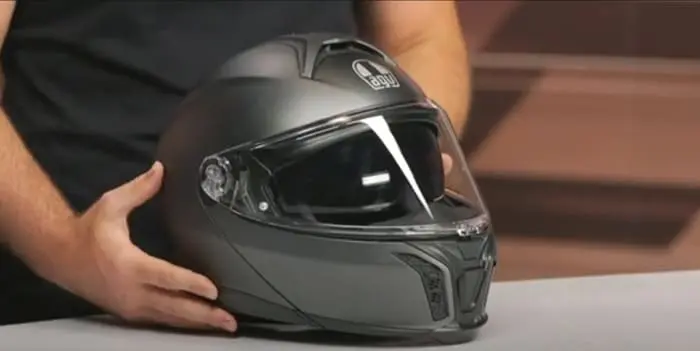
The AGV Insyde, manufactured by Cardo Systems, integrates seamlessly into the Tourmodular lid. It matches the Cardo Packtalk Edge’s features while maintaining a low-profile design.
Installation Process
The installation requires:
- Removing the back plate and left side cover
- Installing the control panel and battery compartment
- Placing speakers in dedicated pockets
- Mounting the boom microphone in a fixed socket
Key Features
Voice Control Performance
The natural voice command design works reliably with the chin bar up. However, command recognition becomes inconsistent with the chin bar down.
Audio Quality
- Dedicated speaker pockets optimize sound placement
- Adjustable velcro spacers for personalized fit
- Clear, distortion-free audio at high volumes
Connectivity Option offers universal compatibility:
- Works with other Cardo devices
- Connects to Sena systems via Bluetooth
- Supports phone pairing for calls and music
Technical Limitations
It shows several drawbacks:
- Uses older USB Mini port for charging
- Voice commands work inconsistently with the closed chin bar
- Limited waterproofing requires careful maintenance
Aftermarket Alternatives
It accepts standard communication systems, though installation may require modifications:
- Cardo Packtalk Edge fits with minimal adjustment
- Sena require additional mounting adaptations
- Standard Bluetooth units need careful speaker placement
The dedicated channels and mounting points work best with the Insyde system, making aftermarket installations more challenging but possible.
Pros and Cons Summary
| Advantages | Disadvantages |
|---|---|
| ECE 22.06 certified | Premium price point ($659.95+) |
| Wide 190×85-degree field of view | Heavier than pure carbon helmets |
| Excellent cooling system | Some wind noise at highway speeds |
| Premium interior materials | Non-removable chin curtain |
| Pinlock 120 included | Limited color options |
| Integrated comm system ready | Tight neck opening |
| Multiple shell sizes | Break-in period needed |
| 4mm thick face shield | Sun visor edge visibility |
| Effective moisture wicking | Voice commands inconsistent |
| True-to-size fit | Limited waterproofing |
Performance Ratings
These ratings reflect my personal experience after 2,000+ miles of testing in various conditions.
Frequently Asked Questions
Does it run true to size?
Yes, it fits true to size. Measure your head circumference and match it to AGV’s size chart for accurate sizing.
How long is the break-in period?
The interior padding typically takes 15-20 hours of wear to conform to your head shape.
What safety certifications does it have?
It meets ECE 22.06 standards and features P/J homologation for both full-face and open-face lids.
Is the Pinlock insert included?
Yes, a Pinlock 120 MaxVision insert comes standard with this lid.
Can I install third-party communication mechanism?
Yes, though it works best with the AGV Insyde system. Standard comm units require careful speaker placement.
Does the Insyde Bluetooth work with other brands?
Yes, it connects via Bluetooth to Sena and other major communication mechanisms.
How does it perform in the rain?
The visor seal prevents water intrusion at highway speeds. The neck roll may allow minimal water entry in heavy downpours.
Does the ventilation work well in hot weather?
Yes, five intake vents and two exhaust ports provide effective airflow up to 95°F.
Final Verdict
It delivers premium features at a circa $659.95 price point. After 2,000 miles of testing, this lid proves its worth for serious touring riders who value safety and comfort.
Key Strengths
It excels in critical areas:
- ECE 22.06 certification for enhanced protection
- Effective ventilation for long-distance comfort
- Premium interior materials that maintain freshness
- Wide field of view with minimal distortion
- Integrated communication compatibility
Ideal Rider Match
This lid fits those who:
- Tour frequently in varying weather conditions
- Value modern safety standards
- Need clear communication systems
- Want modular convenience without compromise
Consider Before Buying
The weight and price reflect its premium construction. I recommend trying it on before purchasing, as the intermediate oval shape and neck opening can affect individual comfort.
Value Assessment
It costs more than basic modular lids but justifies its price through:
- Advanced safety features
- Premium construction materials
- Versatile modular design
- Long-term durability
- Excellent ventilation performance
For those covering serious miles, the AGV Tourmodular’s combination of safety, comfort, and features makes it a solid investment for long-term use.
More Details
Maintenance Guide
The AGV Tourmodular requires specific care routines to maintain its safety features and extend its lifespan. I’ve developed these maintenance tips through extensive testing and regular use.
Shell Care
Clean the exterior with mild soap and warm water only. I use a microfiber cloth to prevent micro-scratches. The shell’s finish reacts poorly to:
- Petroleum-based cleaners
- Abrasive compounds
- High-pressure water
Interior Maintenance
The removable liner needs washing every 30-40 hours of use. My cleaning routine includes:
- Machine wash at 86°F/30°C
- Gentle cycle only
- Air dry away from sunlight
- No fabric softeners
Visor Protection
The 4mm face shield requires careful handling:
- Clean with motorcycle visor cleaner only
- Use a microfiber cloth for wiping
- Replace Pinlock insert yearly
- Lubricate the visor mechanism monthly
Ventilation System
Keep airflow optimal through regular maintenance:
- Brush vent openings weekly
- Remove debris with a soft brush
- Check seals for damage
- Clean mesh filters monthly
Storage Methods
Proper storage prevents material degradation:
- Store in a cool, dry location
- Use a helmet bag for protection
- Avoid direct sunlight exposure
- Keep away from heat sources
- Maximum storage temperature: 140°F/60°C
These maintenance steps help preserve the helmet’s safety features and comfort. Regular care extends the life of premium materials and maintains optimal performance.
Testing Methodology
I purchased the AGV Tourmodular independently for $659.95 to maintain testing objectivity. The helmet underwent 2,000 miles of real-world testing across three months of varied riding conditions.
Test Conditions
Weather Range:
- Temperature: 45°F to 95°F
- Humidity: 30-90%
- Rain exposure: 6 hours
- Direct sunlight: 40+ hours
Riding Environments:
- Highway miles: 1,200
- City riding: 500
- Mountain roads: 300
Equipment Used
My testing equipment included:
- Sound meter for noise readings
- Temperature sensors for ventilation
- GoPro for visor clarity documentation
- Humidity gauge for moisture control
Performance Metrics
Each feature received specific attention:
- Ventilation: 30-minute intervals at varying speeds
- Noise: Readings at 10 mph increments
- Communication: Range tests in different terrains
- Comfort: 4-hour continuous wear sessions
Testing Limitations
Several factors affected testing:
- No winter conditions below 45°F
- Limited group riding scenarios
- Single rider perspective
- Three-month duration only
The testing focused on real-world usage rather than lab conditions, providing practical insights for daily riders.
Technical Terminology Guide
The AGV Tourmodular uses specific technical terms that define its features and capabilities. Here’s a clear breakdown of the key terminology:
| Term | Definition |
|---|---|
| ECE 22.06 | Latest European safety standard for motorcycle helmets requiring stricter impact testing |
| P/J Homologation | Certification for legal use with chin bar open or closed |
| EPS | Expanded Polystyrene foam that absorbs impact energy |
| Ultravision | AGV’s 190° horizontal and 85° vertical field of view standard |
| Z-Lift | Aerodynamic force affecting helmet at highway speeds |
| DMC | Digital Mobile Communication system for rider connectivity |
| Ritmo Fabric | Moisture-wicking material used in cheek pads |
| Shalimar Fabric | Memory foam-based crown liner material |
| Shell Density | Number of protective layers in helmet construction |
| MaxVision | Pinlock’s maximum coverage anti-fog insert |
Safety Standards
| Certification | Purpose |
|---|---|
| DOT | U.S. Department of Transportation safety standard |
| NBR | Brazilian safety standard |
| HAS | Australian safety standard |
| JIST | Japanese Industrial Standard |
| TIS | Thai Industrial Standard |
Construction Materials
| Material | Function |
|---|---|
| Carbon Fiber | Lightweight rigid outer shell material |
| Aramid | High-strength synthetic fiber for impact resistance |
| Fiberglass | Durable shell material with good energy absorption |
| Thermoplastic | Base material for helmet shell construction |
These terms represent the technical foundation of modern helmet design and safety features.
Ideal User Profile
The AGV Tourmodular suits long-distance touring riders who value comfort and safety. This helmet excels during extended highway rides and varied weather conditions.
Riding Styles Match
Sport Touring
- Upright riding position optimization
- Excellent stability at highway speeds
- Clear vision for cornering
- Effective ventilation at speed
Adventure Touring
- Modular convenience for navigation stops
- Weather protection in varying conditions
- Communication system integration
- Pinlock anti-fog for temperature changes
Sport Touring Motorcycles
- BMW R1250RT: Perfect aerodynamic match
- Yamaha FJR1300: Minimal buffeting
- Kawasaki Concours: Good wind protection
Adventure Bikes
- BMW GS Series: Works well with stock screens
- KTM Adventure: Stable in varied positions
- Triumph Tiger: Excellent air management
Riding Conditions
Road Types
- Highway: Outstanding stability
- City: Good ventilation at low speeds
- Mountain: Clear peripheral vision
- Urban: Practical modular function
The helmet performs best on faired motorcycles with proper windscreen management. Sport touring bikes provide optimal aerodynamic compatibility.
User Feedback
Users have reported several recurring challenges with the AGV Tourmodular. The helmet’s design creates specific operational and comfort concerns that buyers should consider.
Mechanical Problems
The P/J chin-bar lock causes significant frustration:
- Located on the right side, it isn’t easy to operate while riding
- Requires tools or bare hands to engage
- Too stiff for gloved operation
Visor Issues
Users report several visor-related problems:
- Left side shield clip falls out unexpectedly
- Visor becomes loose over time
- Limited upward opening range
- Visible black locking clip obstructs view when open
Comfort Concerns
The helmet presents specific fit challenges:
- Pressure points around the jaw after extended wear
- Flat chin curtain needs constant adjustment
- Non-removable cheek pads complicate emergency removal
- Sun visor fogs in cold, damp conditions
Safety Recalls
A recent recall affects certain models:
- Micrometric buckle engagement failures
- Chin strap loosening concerns
- Required dealer inspection and lubrication
Communication System
The Insyde system shows limitations:
- Microphone placement affects connection quality
- Voice commands work poorly with a closed chin bar
- Initial pairing issues with other brands
These issues vary in severity, but they represent the most commonly reported problems across user reviews and forum discussions.
Resources
- Recall: Some AGV Tourmodular lids Could Have Buckle Not Engaged
- Acoustics
- Aerodynamics
- Ambient Pressure
- Anthracite
- Anti-fog
- Antimicrobial
- Aperture
- Arai
- Arizona
- Bacteria
- Bluetooth
- BMW Motorrad
- Buffeting Aeroelasticity
- Cafe Racers
- Carbon Fiber
- Carbon Fiber Reinforced Polymer
- Composite Material
- Coolmax
- Crash Test
- Death Valley
- Decibel
- Detergent
- Drag
- Dual Sport Motorcycle
- ECE 22.06
- Elastomer
- Enduro
- Energy
- Face Shield
- Fatigue
- Fiber
- Fiberglass
- Glasses
- Global Positioning System
- Hearing Protection
- Homologation Motorsport
- Intercom
- Japan
- Kawasaki Motors
- Memory Foam
- Microfiber
- Microphone
- Moisture-Wicking Fabric
- Motorcycle
- Motorcycle Fairing
- Night Vision
- Noise Control
- Noise Pollution


